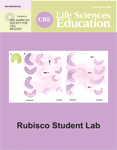The Research Dynamic: A Professional Development Model for Secondary School Science Teachers
Abstract
This essay summarizes the author's 10 years of experience at the Oklahoma Medical Research Foundation mentoring secondary school science teachers during 8-wk Summer Research Institutes. The summary is presented as a learning model, which we call the research dynamic. This model consists of three interlocked components: specified ignorance, peer interactions, and gateway experiments. Specified ignorance is based on the work of the sociologist Robert K. Merton. It is essentially the art of highlighting what is not known about a phenomenon but must become known for further progress. In practice, specified ignorance is framed as a hypothesis, a prediction, or a question. It is commonly the outcome of peer interactions, which are the second essential component of the research dynamic. Peer interactions are the inevitable outcome of having teachers work together in the same laboratory on related research topics. These topics are introduced as gateway experiments, the third component. The most important attribute of gateway experiments is their authenticity. These experiments, when first carried out, opened new scientific vistas. They are also technically, conceptually, and logically simple. We illustrate the research dynamic with a line of seminal experiments in biochemical genetics. We provide evidence that the research dynamic produced significantly positive effects on teachers' confidence in their professional preparedness.



